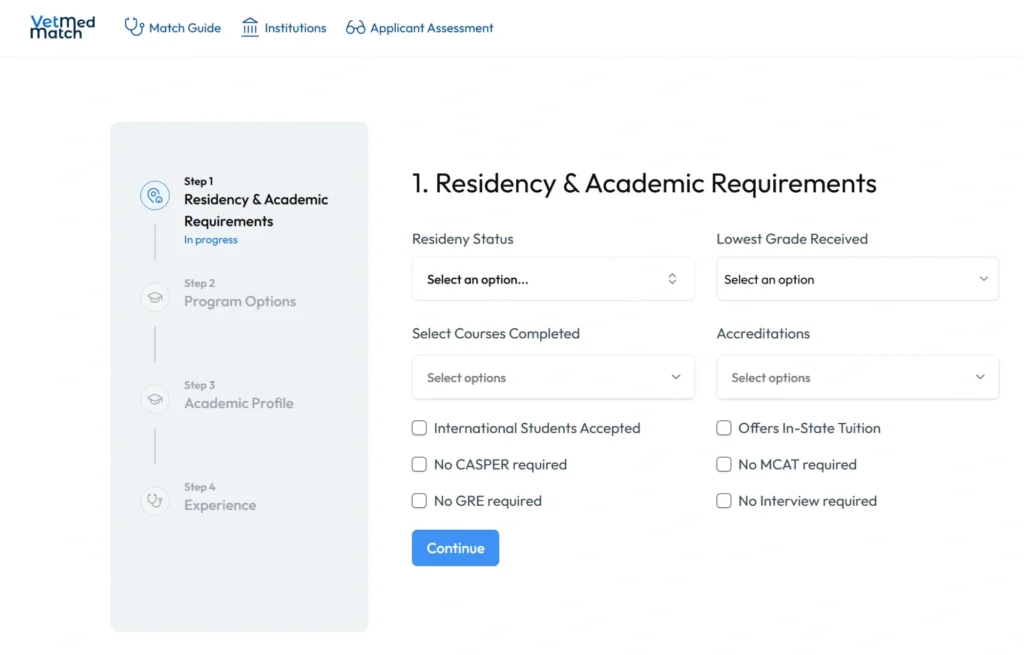About the Writer
The Ultimate Veterinary School Application Checklist

Are you ready to begin applying to veterinary schools?
From gathering documents to meeting deadlines, there’s a lot to keep track of and consider when preparing your vet school application. Plus, forgetting a key step could put your chances of acceptance at risk.
With our veterinary school application checklist, you’ll have a clear roadmap to stay on top of everything, and you won’t have to worry about missing any deadlines along the way.
Simply go through each step and check it off (mentally or on paper) as you go!
Veterinary School Application Checklist
Use this checklist as a quick reference, and tick off the boxes when preparing your vet school application:
1. Research Veterinary Schools
2. Meet Prerequisites
3. Complete the VMCAS Application
4. Get Ready for the GRE (If Required)
Register and pick a test date
Use prep guides and take practice tests
Focus study on weak areas
Send scores to schools on time
5. Write Your Personal Statement
6. Secure Letters of Recommendation
1.Research Veterinary Schools
Exploring different veterinary schools will help you find a program that aligns with your career goals and learning style. Ideally, aim to shortlist at least five schools to apply to, though the number may vary based on your preferences, eligibility, and application budget.
Explore Different Veterinary Schools and Programs
Take your time exploring the websites of various veterinary schools.
The best veterinary school program for you will depend on factors like the curriculum, faculty, specializations, clinical experience opportunities, and location.
You can check out online forums such as Reddit to find honest reviews of different schools from past and present students. Then, use our VetMed Match interactive tool to find a veterinary program that’s the perfect fit for you.

Note Application Deadlines and Fees for Each School
Each veterinary school has different admissions processes, application deadlines, and fees.
If you miss a deadline, forget to pay the fee, or leave out any required information, your application could be delayed or even rejected. Be sure to check each veterinary school’s admission process for deadlines and fees and keep track of them in a notebook or spreadsheet.
Compare Tuition and Scholarship Opportunities
Vet school costs can vary. For each school that makes it into your list, find and note the following to see:
- tuition costs
- financial aid
- scholarships
This will make it easy to see what fits your budget. You should also consider the cost of living, including housing, transportation, food, and other daily expenses for each shortlisted school.
Visit Schools
If you can, visit the schools on your shortlist to tour the facilities, meet faculty, and chat with current students. These visits can give you a better feel for the campus, and an idea of what studying at each vet school will be like. Remember to check for upcoming open house dates as part of your planning.
2. Meet Prerequisites
In your veterinary school application, you must share proof of your education and work experience.
Find Out Test Scores and Other Prerequisites
Some veterinary schools require standardized test scores, such as the GRE, while others may have specific coursework or experience requirements.
Review each school’s admissions page to understand what’s needed and start preparing. For example, at UC Davis School of Veterinary Medicine, the GRE is no longer required, but all applicants need at least 180 veterinary experience hours and a bachelor’s degree from a regionally accredited university.
Create a Log of Your Work Experiences and Hours
A lot of vet schools want proof of your animal-related experience. Make sure to keep a record of your hours, what you did, and where you worked, such as shadowing a vet, interning, or volunteering.
Having everything written down with exact details will make it easier when it’s time to fill out your application.
3. Complete the VMCAS Application Process
The Veterinary Medical College Application Service (VMCAS) supports the application process for many veterinary schools. When researching different schools, you should find out whether they accept applications through VMCAS. The VMCAS 2025 deadline is September 16 at 11:59 P.M.
Create an Account on the Website
The VMCAS suggests creating your account at least three months prior to the application deadline. You’ll need to include basic details such as your name and contact information.
Once you’ve done this, you’ll receive a VMCAS ID number, and you can complete the extended profile section. You’ll be prompted to add additional information, such as your intended term of enrollment and your current academic status.
Upload Transcripts
After completing all sections, you’ll mail your official transcripts, which can be ordered from your previous schools or colleges in the application portal. You can find detailed instructions for doing so in the VMCAS applicant guide.
After requesting your transcripts, follow up with your schools to ensure they were sent. Then, monitor the Check Status page on VMCAS to confirm they have been received.
On average, it takes up to seven business days for a transcript to be processed and posted to your application after being received.
Double-Check for Errors and Inconsistencies
After uploading transcripts and entering details such as your experience, achievements, and coursework, you should review your entire application.
Check for spelling or grammatical errors and verify that dates and logged experience hours are correct. Make sure no required sections are left incomplete. A thorough review can help prevent delays or issues with processing.
Submit the Application Before the Deadline
Regularly check the status of your application and make sure all materials have been received and processed.
Submit your application well before the September 16th deadline to avoid any last-minute issues.
4. Get Ready for the GRE
If any of your shortlisted vet schools require the Graduate Record Examination (G RE), you’ll need to study for the exam and complete it before the application deadline.
Register for the GRE and Choose a Test Date
Head to the GRE registration form to create an ETS account. You can then schedule your GRE test. Remember to give yourself plenty of time to study and prepare.
Tip: You’ll likely receive your score report 8 – 10 days after your test date. When scheduling your test, ensure your scores arrive before application deadlines.
Complete Practice Tests
Although you don’t need to, we suggest finding your baseline score by taking a GRE practice test. You’ll see what grade you’ll get and an idea of the test’s structure.
Compare your practice test scores to the average GRE required or suggested for each veterinary school program. For instance, although Ross Veterinary School doesn’t have a minimum score requirement, the average GRE score is 300 for enrolled students.
Study for the Test
After a practice test, you can set a study schedule. Focus on improving sections where you struggled and allocate time each week to practice.
Use your local library for GRE prep books, study guides, and other resources to help you study.
Take the Test
After preparing and studying, you can take your GRE either at home or at a test center. For home tests, you need a computer, speaker, camera, and microphone.
Before test day, check that your equipment is working properly and that you meet all environmental requirements.
Send Your Scores to Schools
Once your scores are available, log into your ETS account to send them to your selected veterinary schools.

5. Write a Personal Statement
You’ll often need to submit a personal statement according to your school’s requirements.
Your statement will offer a glimpse into your passion, dedication, and experiences, giving your application reviewers a better understanding of who you are and why you’ll be a good fit for the program.
Plan What to Include
Before you start writing, outline the key points you want to highlight. You’ll want to focus on your motivation for pursuing veterinary medicine, relevant experiences, personal strengths, and future goals.
Check out our step-by-step guide to writing a personal statement for more in-depth guidance.
Tip: Keep in mind that some vet schools will have specific prompts or guidelines for personal statements.

Write Out the Statement
Consider starting with a hook, like a quote or quick story, to catch your reader’s attention.
Write a few paragraphs highlighting your skills and experiences. Use specific examples to demonstrate your qualifications rather than just listing them, and avoid exaggerating or over-dramatizing.
Finish with a brief conclusion reinforcing your passion for veterinary medicine and your readiness for the program.
Proofread
After writing your statement, take time to proofread for grammar and clarity. You can use free tools such as QuillBot. Then, read it out loud a few times to catch any awkward phrasing.
We suggest asking a mentor or friend to review your statement and offer any helpful feedback.
6. Secure Letters of Recommendation
Letters of recommendation show your abilities, work ethic, and personality through the perspective of others.
Vet schools usually require at least one letter of recommendation, but some will ask for two or more, often from different sources such as veterinarians, professors, or supervisors.
Choose Recommenders
Carefully choose and ask recommenders who can vouch for you. Ask well in advance of your vet school application deadline to give them plenty of time, ideally several weeks or months, to write and submit their letters.
Provide Recommenders With Your Resume and Personal Statement
To keep your application more focused, you can share your resume and personal statement with recommenders.
They’ll better understand your goals and may tailor their letters to highlight the qualities that best support your application.
7. Prepare for Interviews
Most veterinary schools complete one-on-one or panel-style interviews with applicants as part of the interview process. The impact your interview has on your application can vary between schools, but not being well-prepared is a top mistake veterinary school applicants make.
Practice Common Veterinary School Interview Questions
Get comfortable with the types of questions you might be asked in your vet school interview, such as:
- Why do you want to be a vet?
- How do you handle high-stress situations?
- How do you approach studying and learning new material?
- How do you stay motivated when faced with challenges or setbacks?
Try to think of past experiences you can use in your answers. Sharing personal stories or examples will help show your knowledge and ability to apply it in real-world situations.
Schedule Mock Interviews
If you can, practice mock interviews with professors, mentors, or even friends. This will help you feel more prepared and confident for the real thing.
But remember, there’s a fine line between being well-prepared and over-prepared. If you rehearse too much, you might appear too stiff or inauthentic, which won’t leave a good impression on your interviewers.
Choose Appropriate Clothing for the Interview
Make sure you have the proper clothes for your interview, such as a suit or blazer and a button-down shirt or blouse.
Even if your interview is online through a video meeting, you should still dress professionally to show your interviewers you’re serious about the opportunity and respect the admissions process.
Applying to Veterinary School With Confidence
Checking off each item of this vet school application checklist will keep you organized and on track for a smooth process.
But applying to vet school is just one step on your journey toward becoming a veterinarian.
At Vetucore, we provide aspiring vets with the tools and resources they need, supporting them during the application process and all the way through their studies.
With us, you’re never alone on this journey. We’re here to provide the support and guidance you need every step of the way.
